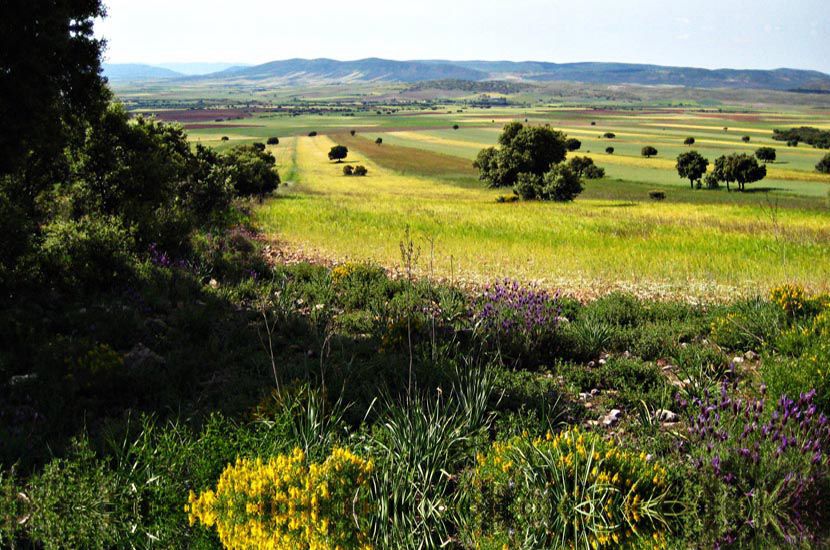
1. Welcome

Welcome to Cabañeros National Park Visitors’ Center. My colleagues have chosen me to accompany you on a tour through the rooms that we are going to visit. We’ll discover many treasures and secrets that hold this wonderful natural park. I have many things to tell you, so let's get going with the audioguide. But before we begin, let me introduce myself. My name is Silvia and I’ve been working in this park for many years. I'm a biologist and I take care of different tasks related to the care of many species that can be found in this park. There is never two days alike in my work.
In the park everything is a magical world, constantly changing, where there’s hardly a week that we don’t enjoy an intense and unrepeatable moment. It’s difficult to choose one day in particular. It could be the stunning deer bellow. The migratory passage of thousands of cranes. The birth of a black vulture’s chick, or the overwhelming emotion that makes us to see the trace of the almost wiped out Iberian lynx, knowing that some of them are not far away from here. I know I'm very lucky, as well as the visitors who come to see us, because Cabañeros Park is perhaps the best National Park to watch wildlife in Spain in its natural habitat, and one of the most important protected areas in the Iberian Peninsula.
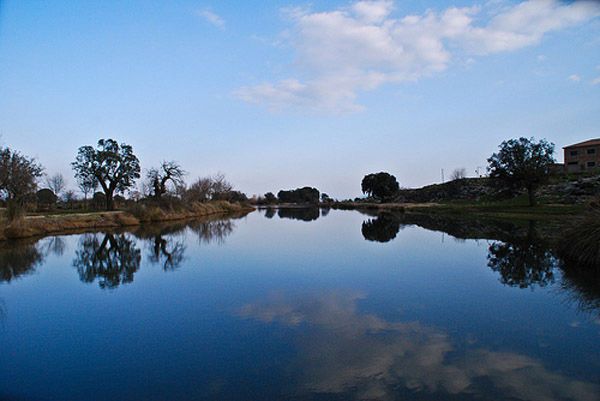
Thus, it’s still surprising to remember that all this could have almost disappeared in the eighties of last century, when the Government wanted to turn Cabañeros into a firing range for the Army. The wide social response against this initiative along with the Government of Castile-La Mancha intervention fortunately stopped this project. Finally after a long process, cabañeros was declared a National Park on November 20th 1995.
Time has given us the reason to those who fight for the preservation of Cabañeros Natural Park. Its natural values have become one of the greatest National Parks network’s jewels, where stands out a Mediterranean forest’s ecosystem. Now you’ll understand why we want to share it with you. I hope you enjoy the visit with the audioguide! Thank you for visiting us.
2. National Parks
Before leaving the lobby in order to begin your tour through Cabañeros National Park, don’t miss the information that can be found with the audioguide on one side of this room. You will be able to know in detail the Spanish National Parks Network, made up of 15 natural areas protected by the figure of National Park, after the latest incorporation of Sierra of Guadarrama National Park. This Network brings together the most representative and best preserved Spanish natural heritage. The purpose sought with the declaration of National Park is: To ensure the conservation of their natural values. Make these conservation measures compatible with the use and enjoyment by the people in each park. Promote the research and knowledge that we have about each of these areas.
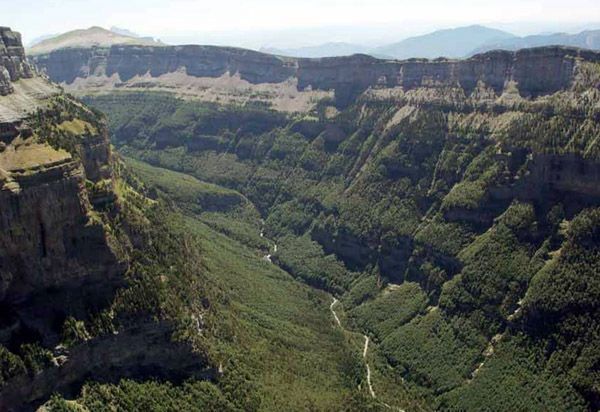
In addition, National Parks have become in recent years, an important engine for the economic development of each region where they are located. In collaboration with town councils and companies, we try to promote a type of alternative offer for sustainable use, consistent on a quality of life’s model which is everyday more interested in the conservation of nature. More and more people come to visit us! Did you know that each year more than 10 million visitors enjoy National Parks? Get closer to the panels with the audioguide and read the information of each of the 15 National Parks that exist so far. You can also enjoy an interactive that will provide you more information and details about each one of these areas.
Look at the Cabañeros National Park’s panel. I recommend you to visit all visitors’ centers that we have here, so don’t miss it! In addition to the interesting content that show each one of them, my colleagues will give you more information to organize your visit the best way possible. And that’s because there are many ways to visit the Park: We have fifteen signposted routes, two of them in 4x4 vehicles. An storks observatory. A viewpoint to watch La Raña’s wildlife. Two recreational areas where you can rest during the visit. And don’t forget the wide range of activities that offer the tourist companies located in the region.
We are also involved in many research projects and conservation programs where take part biologists, scientists and experts from across Spain. One of them is called "Flying off". It‘s a program made with the collaboration of SEO / BirdLife which consist of the installation of a camera inside a pair of Imperial Eagles’ nest. On the screen next to the 15 National Parks’ panels, you will be able to enjoy the stunning live images that films this video camera allowing us to follow the daily life of these predators, one of the Mediterranean forests’ symbols. As you can see, I didn’t exaggerate before when I told you that I had a lot of things to tell you. That’s why I'm sure you'll have more than one reason to return to Cabañeros National Park!
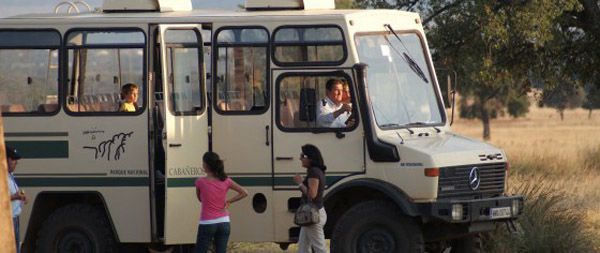
3. The Geological Wall
The park is located in the Toledo Mountains, an area that has some of the oldest mountain formations in the Iberian Peninsula, being more than 500 million years old. It’s now hard to imagine, but all this area was submerged under the sea at that time. That’s why we have important paleontological sites of marine origin, where up to 250 species of some of the earliest Earth‘s inhabitants can be found, such as trilobites and cephalopods. Before leaving the room, be sure to see the replica of these large ichnofossils. They are the remains of fossilized animals. You’ll be able to see more like these in the visitors’ Center "Sticks House", near Saint Quiteria. A long time later, 2.5 million years ago, during the Quaternary period, appeared in Cabañeros Park a kind of fauna that could be relate today to the African savannah, with large mammals such as the mastodon.
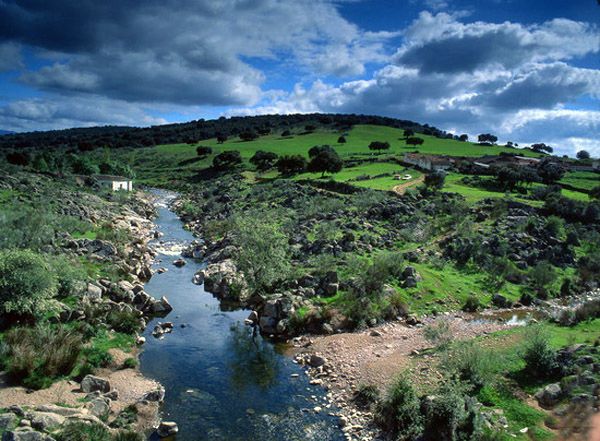
We have found the remains of one of them in La Rañas’s southern Cabañeros National Park. Its head and fangs can be seen also at the Visitors’ Center "Sticks House". Look now at the room’s large front wall. Here one can see a recreation of Cabañeros National Park’s geological section. It has, from top to bottom, eight horizontal layers that can be found in the Park made of different geological materials which are arranged chronologically.
Get closer to the panel next to it while listening to the audioguide, it will provide you more information in order to understand this stratigraphic sequence. Pay attention and look at the details of each stratum. Imagine that each one contains millions of years of Earth’s geological history. And now think that our specie, Homo sapiens sapiens, has just been inhabiting this planet for 200,000 years. Amazing, isn’t it? I'll be waiting in the Room of the Seasons, where we’ll begin our tour through Cabañeros National Park’s natural areas.
4. The room of the seasons
You are about to begin a fantastic tour through Cabañeros National Park with the audioguide. Pay attention and look at the details you’ll find a long the way, since you are going to be a privileged spectator in the continuous changes that occur throughout the year in these wonderful natural surroundings.
If we pay attention to what’s happening around us, we’ll find many clues that will reveal the change of seasons as the year goes by.
There are in Cabañeros Park two migratory species that mark in a special way, these moments: The stork and the crane.
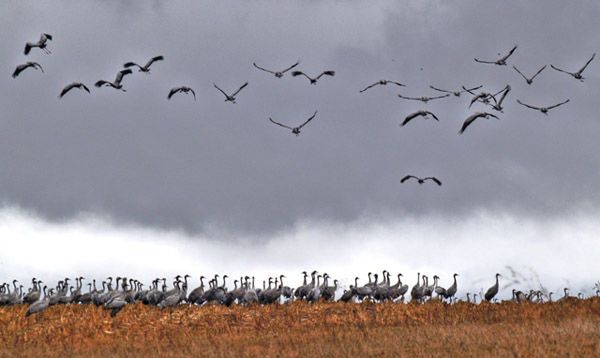
Anticipating the end of winter, many storks from Africa come to the Park in February. Almost at the same time, the cranes that have spent the winter here set off northwards. The same route will happen again in different direction six months later.
But before beginning our tour, it’s important to understand why these seasonal changes occur, affecting directly our planet’s cycle of life.
The main reason of the four seasons is due to the inclination of our planet’s rotation axis, in relation to the orbit which describes its annual rotation around the sun. If we look at the Northern Hemisphere, the more tilted towards the sun that axis is, the hotter it is and longer the days are. Heat rises because that part of the planet receives more solar rays. When the tilt towards the sun is lower, solar rays affect fewer hours over this Hemisphere’s earth surface. This causes a drop in temperature and longer nights.
In the next rooms you’ll find a selection of the best scenes that take place in Cabañeros National Park’s ecosystems during the different Seasons of the year. Get ready to travel through time and space with the audioguide to discover the nature highlights in the Iberian Peninsula, the main wildlife events and the unique Park’s vegetation. Are you ready to begin this journey? I’ll be waiting at the Vernal Equinox room.
5. Vernal Equinox. Wings in the sky
In this room you are going to witness the spectacular migratory birds of passage that happen in Cabañeros Park around March 21st. This date marks the Vernal Equinox and consequently the change of season leaving behind the cold winter. At this time of the year is when the Park’s skies are filled with thousands of birds that set out for different routes depending on where their breeding grounds and wintering areas are. Summer nesting birds coming from sub-Saharan Africa, overwintering birds returning now to Northern Europe and birds of passage to other destination areas will meet in Cabañeros Park during the next weeks. During these days the shouting of these large flocks of birds will be heard in every Cabañeros Park’s corner.
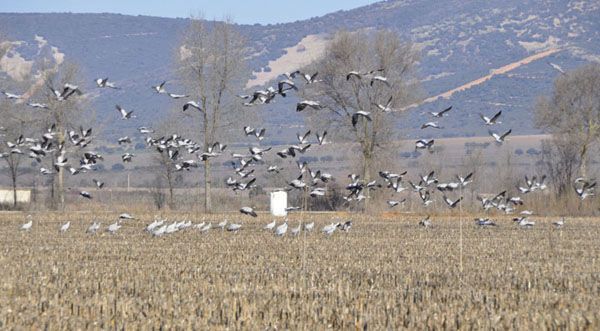
Let’s see now in detail which these birds are. Listen to the audioguide and look at the left panel. First, you’ll be able to see a group of overwintering birds and their migratory routes on a map.
These species, such as the Crane, the Lapwing, the Golden Plover, the Hedge Sparrow and the Thrush, have just spent the winter in Cabañeros Park, avoiding the cold of their places of birth in Central and Northern Europe. From this moment on they’ll begin their journey back to those areas in order to breed. In the fall, when their new chicks are already able to fly by themselves, they’ll come back together to the park. Get closer to the panel and discover which the most representative overwintering birds are and which main routes they take. In this same panel, a little bit further, we find the birds of passage in the park and a map that also explain their routes.
Do you know why they are called birds of passage? It is easy to guess. They are birds that usually not live in this Park which are now in the migration phase. These birds use Cabañeros’s territory as a rest point in order to feed until they reach their final destinations. Cabañeros Park’s strategic position for these birds routes and the attraction that offer its natural environment for these birds to get their strength back, makes this area a basic place for the their survival. Some of them, such as the Common Chiffchaffs, the Redstart, the Lark and the Whinchat, are shown in this panel. You can see on the map in detail the routes they take during their journeys. Look now at the right panel where you can see a third group of migratory birds in Cabañeros Park. They are the summer nesting birds.
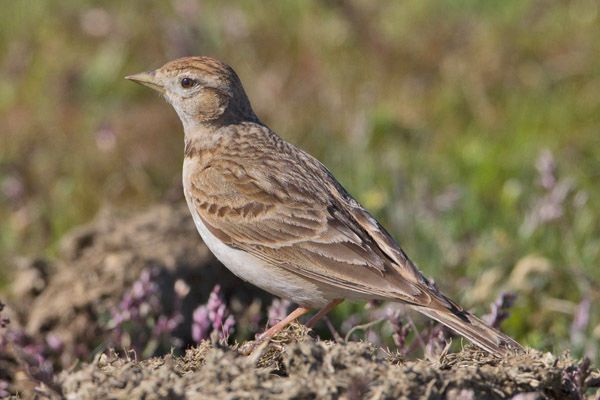
Coming from the sub-Saharan African, they start now to come at Cabañeros Park after spending the winter there. During the next weeks it will begin the mating season. Those without a partner, we’ll try to find one, and all of them will raise their chicks here until they are ready to begin their journey back to Africa next fall. Some of these birds such as the White Stork and the Swallows will be familiar to you. Others such as the Black Stork, the Lesser Kestrel, the Red-Necked Nightjar or the Eurasian Golden Oriole maybe not. Get closer to the panel to know them better. You will see in detail each one and the route they take each year during their migrations.
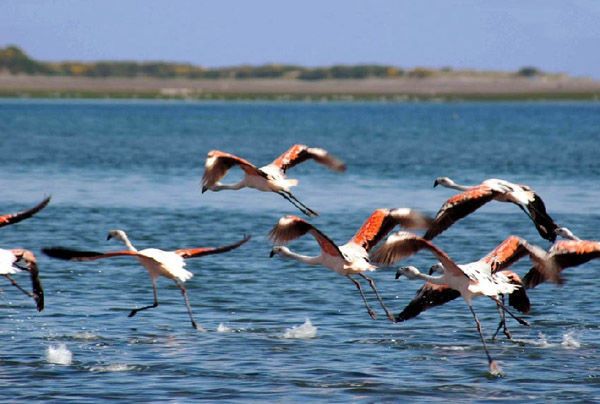
If you want to know more about Cabañeros Park’s migratory birds, get closer to the interactive that is in the middle of the room and enjoy the activities that the audioguide suggests. With the interactive "Birds Migration" you’ll learn many things about seven migratory birds’ routes such as the Booted Eagle, the Short-toed Snake Eagle, the Ratchet and the White Stork as summer birds from Africa, the Crane and the Red Kite, as overwintering birds from Northern Europe and the Black Vulture as a permanent resident in the Park. We’ll meet in the next room to discover the meadow in Cabañeros Park in spring.
6. Spring in the meadow. Magnificent on the grass
Let's continue our visit with the audioguide. We are facing one of the most common landscapes in Cabañeros National Park: large areas of grasslands dotted with holm oaks. It’s the end of April. It's midday and the sun is at its highest point. The recent rains and the rising in temperature at this time of year have caused the pasture to look green with a great number of wild flowers. The breeding season have begun for many species, the moment where life comes up in every corner of the Park. But as inevitable counterpoint, death is also present, so necessary to continue nature’s cycle of life.
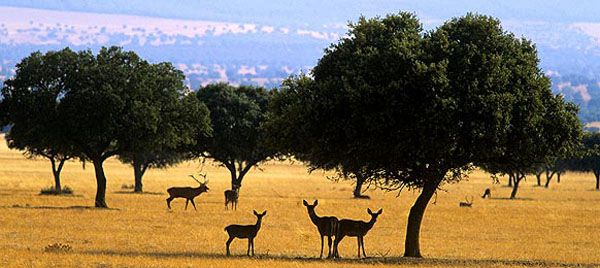
That is what’s happening in the scene you can see in front of you. A group of Griffon Vultures are giving a good account of the carrion of a large herbivore, lying dead on the ground for days under a cloud of flies. Some of these vultures, with their heads and necks covered with blood, gather around the remains of this corpse while moving in short jumps with their spread wings. Others fight against each other to get a good spot in this feast and get the best bites. There are no rules in this chaos, the strongest wind almost always.
This deafening shouting increases with the arrival of two Black Vultures. One of them descends flapping its huge wings to pounce on the group in order to make room for him in the banquet. Perched on the right, the other vulture, stunning due to its size and black figure, makes a screech noise as awaits patiently for his turn between a Griffon Vulture and an Egyptian Vulture. There’s no denying that it’s amazing to see the three scavenger species together in the Park.
The Egyptian vulture, due to its smaller size, awaits resigned and quietly for the others scavenger birds to finish in order to eat the leftovers stuck to the bones.
You may be surprised to see two storks surrounded by vultures. Have you recognized them on this scene’s left side? When they are hungry they don’t leave behind a good carrion piece.
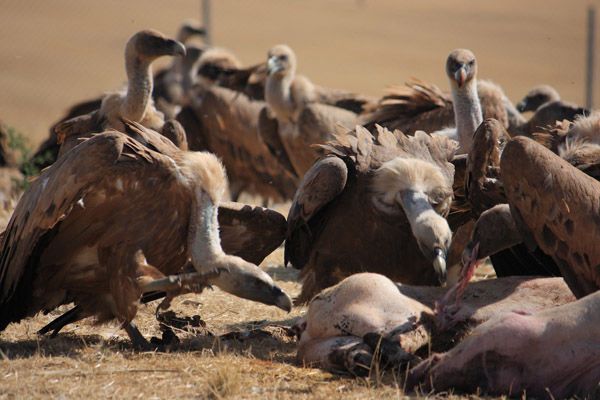
Flying in the air above the dead corpse are two characteristic birds from the Mediterranean pasture. To the left, a pair of Black-Winged Kite during the breeding season, look down over the meadows to find small rodents between the grassland.
Near them, a lonely Black Kite flies slowly while looking for food for the female which is not far from him. If you look at the scene’s right side, you'll see her at the holm oak’s top. The female is in the nest incubating the eggs laid in the second week of April. In a bit more than a week her chicks will be ready to hatch.
This area of the scene around the holm oak shows the great diversity of birds of prey that inhabit the Park.
Look up now over the holm oak’s branches. To the right appears a Short-Toed Snake Eagle nest. The female is taking care of the newborn chick, feeding it with tiny pieces of snake. Very soon it becomes quite noisy in demand for food, so the male must constantly look for preys in order to feed the chick and the mother.
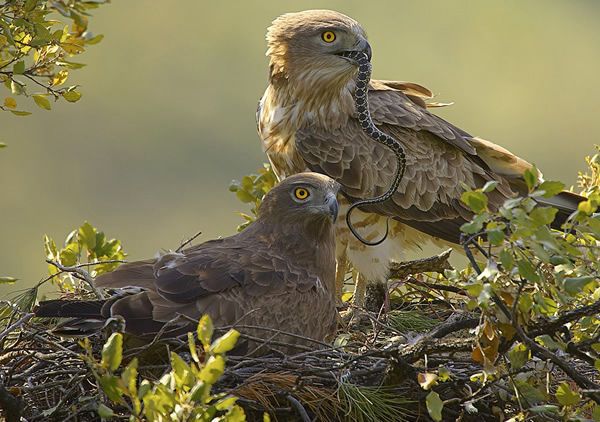
Further down over the holm oak´s trunk, there is a Booted Eagle perched on the branches. Returned to the park a few days ago after spending the winter in Africa and is looking now for a perfect place to nest. His partner must not be very far since they usually fly together, especially now that it’s the mating season.
Look up again to the right while listening to the audioguide, over the tree’s top stands out the silhouette of a Common Buzzard. It’s common to see her alone, but the male must be near, since they a very territorial specie. Once they established in a particular place, they come back to that area again throughout their life. This Common Buzzard has been perched here for a while watching its territory to defend it, if necessary, from others invaders in search for food.
Look down and notice now the scene’s background. A fox slowly approaches the carrion poking its nose out of the pasture. Drew by the corpse’s smell, grunts and sighs with a shriek while waiting his turn. He knows he’ll be one of the last to eat and hardly will find juicy scraps to put in his mouth.
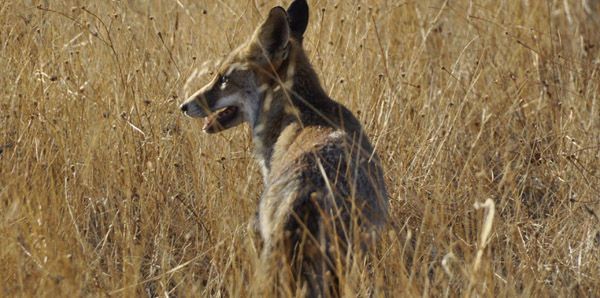
An Ocellated Lizard escapes climbing up a tree trunk in order not to become the fox’s food. To the right a noisy group of Eurasian Magpies, screeching nonstop and chasing each other, also await for the large carrion birds to finish their feast. They may have probably been the first ones to arrive after finding the dead corpse. Their presence and noise alerted the vultures and crows, and now they will have to wait to get some of the last leftovers.
In the end nature sets its own hierarchies and the different species are forced to adapt to those circumstances in order to survive.
Soon calm will return to this Cabañeros Park. The feast won’t last much longer and in a few minutes some vultures’ peaks hitting against the corpse’s bones will be only heard. After the feast, most birds will rest under the sun with their extended bloodstained wings to let them dry and disinfect.
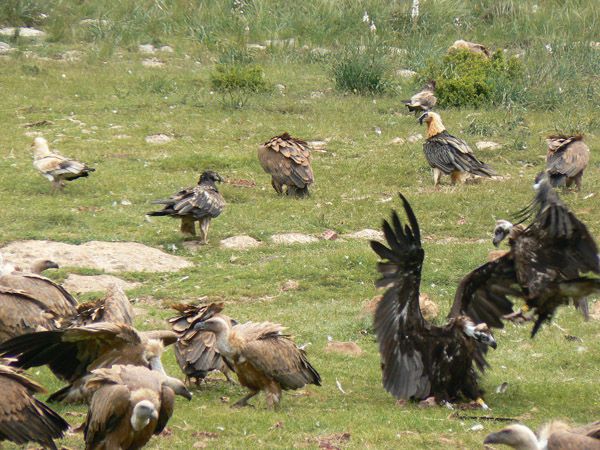
If you want to know more about the meadow and the species that inhabit it, get closer to the screens which are next to the scene and enjoy the activities that the audioguide suggests. With the interactive "Who's who?" you’ll be able to get more information about the scene and species represented in this room. The game "Vultures" allows you to know better four scavenger birds: The Griffon Vulture, the Black Vulture, the Egyptian Vulture and the Bearded Vulture. With the game "Tell me what you eat and I’ll tell you who you are" you’ll know the different diets for each species and how affect them. I’ll be waiting in the next room to discover the Summer Solstice.
7. Summer Solstice. The longest day of the year
In this room you’ll easily discover with the audioguide the similarities and differences between two birds that can be found in Cabañeros Park: The common and abundant White Stork and the most elusive and scarce Black Stork. Look closely at the two scenes that are shown. Although at first glance both storks look to have much in common, let me explain some of their differences. If you ever look up into the sky and are lucky enough to see any of them, then you will be able to tell them apart perfectly.
Look at the right scene. Dawn is breaking in Cabañeros Park and the sun rises in the distance between the mountains.
A pair of White Storks is next to a huge and heavy nest which they have built on the dry gall oak tree’s bare branches. They are both taking care of their two chicks born several weeks ago. For the young female this is her first egg-laying. She paired off, for the first time with this slightly bigger male, last winter which lost his previous partner a year ago. Both will spend the rest of their life together.
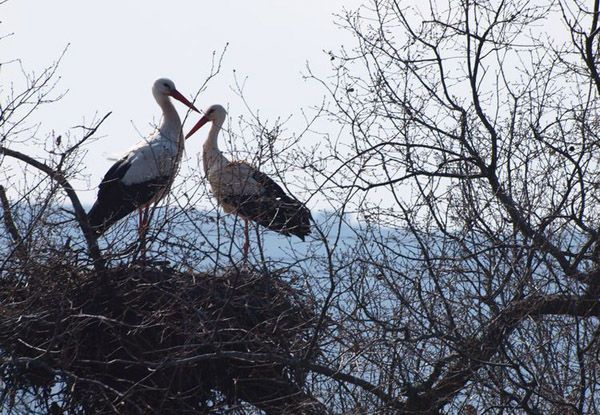
That’s why the still inexperienced female is restless and doesn’t stop making that peculiar noise which happens when hitting quickly her jaws while her head bends back almost touching her back. This rhythmical tapping can be amplified sometimes thanks to her inflated throat, which acts like a real sound board, projecting the sound far away.
The female gets nervous by the impatience of her two offsprings. They have just woken up demanding loudly their breakfast. The parents work to feed them is tireless. Every two hours they should bring food to the nest which regurgitate so that their offprints can eat. This work will reward them in a month when the chicks are ready for taking their first flight.
Look now at the left scene that the audioguide is about to describe. The long and hot day is coming to the end. The night is about to come and it’s already getting dark. A female Black Stork is perched near the nest vigilant while taking care of her small and hungry chick. The chick hatched a few weeks ago and unlike its parents it’s still covered with a white plumage. It’s still a month until the unmistakable feathers which characterize this specie come out.
One of the adults has just arrived bringing the chick’s last food for today. He has caught a tasty toad which will regurgitate in a moment at the bottom of the nest so that the chick would eat.
Look carefully where the nest is set up. Do you know what kind of tree is? It’s one of the most common trees in the park. The nest is built atop a tall and leafy gall oak tree, away from potential predators such as Foxes or Genets. It has taking them a couple of weeks to build it. Over the base made up with sticks, a flat structure was set up with soil and grass upholstered inside with plenty of moss.
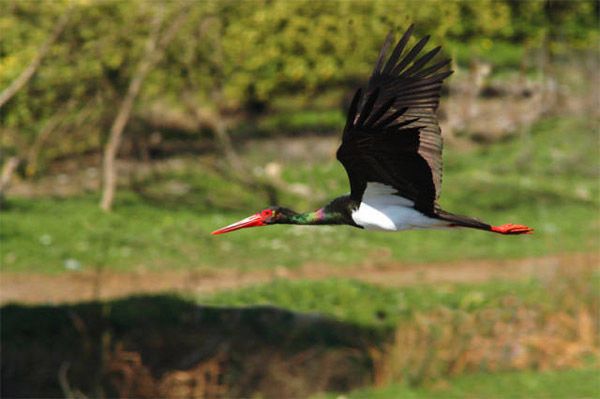
The Black Stork is a solitary bird during the breeding season. The nearest nest can be found many miles away. So let this couple chat before they go to sleep. They are having a lively and noisy conversation exchanging whistles with husky songs. It looks like today they have many things to tell to each other.
Don’t miss the audiovisual you can find in this room if you want to learn to draw well the storks’ shape in detail. And then don’t forget to see the interactive displays where you will learn to do it in a fun way. I'll be waiting in the next room to discover La Raña of Cabañeros in summer in the next point of the audioguide.
8. Summer in La Raña. At the holm oak tree’s shade
We are facing at La Raña of Cabañeros, a vast herbaceous plain dotted with trees that remember the great African savannas’ landscape. It’s mid-afternoon in the month of August. The day is beginning to end, but one can still feel the suffocating heat in the air. This dryness sensation comes with the usual summer symphony made by the sound of cicadas.
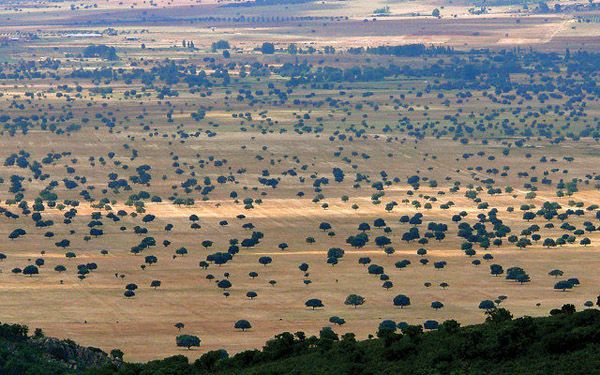
A big centenarian holm oak tree stands out in the middle of the scene, between brown and yellow dry grass shades. The temperature is more humid under its dense crown which allows vegetation to remain cooler. Because of that, the shade which cast on the ground gives shelter to several species in summer. Like this hind which looks after her two fawns, the biggest correspond to last year's litter. They’ve been resting here for hours while protecting themselves from the burning sun rays.
The few shades in La Raña are very appreciated in the hot months and often they have to be shared. Look at the new animals that come running from the scene’s left side. It’s a group of wild boars. Leading the group is an imposing male followed by the female and their three small young wild boars which play hidden in a small kermes oak tree
Look now at the holm oak’s right side. Some African birds rest on a dry tree’s branches, a Genet and a Wild Cat doze quietly while waiting for the sun to set in order to star their hunting since they are night predators.
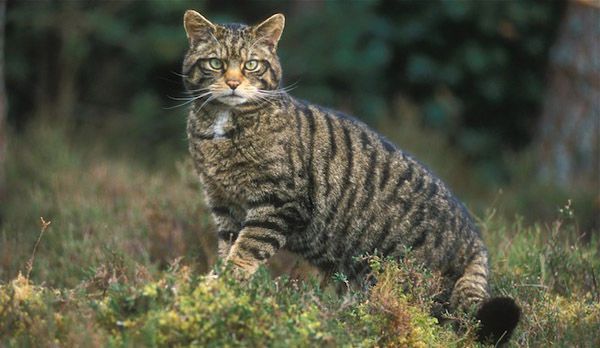
Notice the base of this dry trunk. A curious hare is still scanning the horizon. He’s not aware of the proximity of the two fearsome predators, a mistake that could cost him dear. A Fox and an Ichneumon have laid their eyes on him ... and rarely a prey gets away from them.
…Although it seems like this hare has been very lucky today.
Further to the right you can see a cheerful colony of Bee-Eaters. Their bright and colorful plumage stands out against the sandy slope of land where they build their nests. This location and height make impossible for the predators to reach them. Look now at the central holm oak’s left side on the other side of the scene.
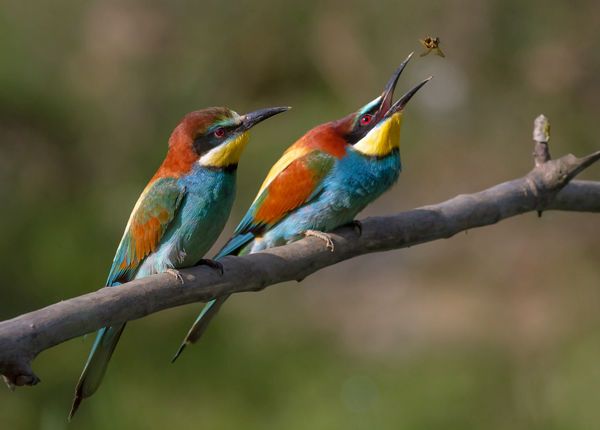
You’ll see several Steppe Birds species, among which due to its size, the Great Bustard stands out. Pay attention to these birds’ brown and gray colors. It allows them to camouflage easily between the dry grasslands in La Raña in summer.
Look up at them while listening to the audioguide. A Common Kestrel beats its wings quickly with its tail deployed and a Kite Bird flies around making wide circles in the air. Both make the most of the air currents while exploring the field closely in search for their favorite preys such as insects and little birds in case of the Common Kestrel and Steppe Birds’ chicks in case of the Kite bird. The Kite Bird has laid his eyes on a partridge and is about to swoop down to catch it by surprise with its claws.
The end of the day approaches. The sun begins to set in the distance. An imposing sound fills the air in the Park.
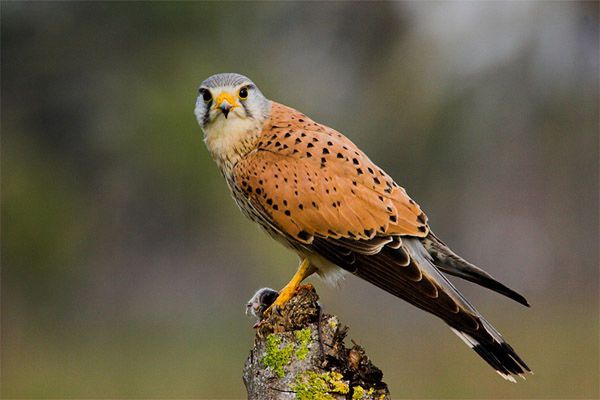
It’s the first adult male deer bellow in response to the beginning of females in heat. It’s about to start one of the most amazing nature moments, the deer bellow, meaning the end of summer in Cabañeros Park. In the next room you’ll be able to know better what the bellow is about.
If you want to know more about La raña’s ecosystem and the species that inhabit it, get closer to the screens which are next to the scene and enjoy the activities that we suggest in this audioguide. With the interactive "Who's who?" you’ll be able to get more information about the scene and species represented in this room. The game "Steppe Birds" gives you different clues to identify a group of this type of animals. With the game "The food chain" you will have to sort out the different species involved in the food chain. I’ll be waiting in the fall to discover the woodland in Cabañeros Park.
9. Fall in the woodland. Stars in the forest
The change of season is starting to be noticeable in Cabañeros Park. The smell of wet soil by recent rains, the colder temperatures and the gall oaks trees’ ocher tones leaves which stand out from holm oaks’ and corn oaks’ thicket, are evidence that fall had arrived to the Park several weeks ago. It’s the end of October. The morning is dawning and some shy sun rays try unsuccessfully to heat the ground. The forest seems to wake up and in a while all its inhabitants will be in full activity. Pay attention to what is happening in the main scene. You have a great opportunity to see with the audioguide three of Cabañeros Park`s main protagonist together such as the Iberian Imperial Eagle, the Black Vulture and the Iberian lynx. Three corn oak trees stand out in the scene’s foreground in front of you. Look at the one in the middle.
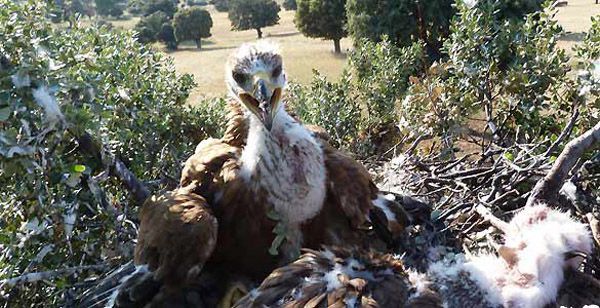
A pair of Iberian Imperial Eagles nested on one of the branches last spring, not far from the ground. To the right, perched on another branch, the parents watch proudly their chick already grown-up and fully feathered. It wasn’t easy to be able to feed him during these months. His other brother died when he fell from the nest soon after hatching. The young eagle is about to leave definitely the nest to look for other territories to settle down. Within three or four years, will have become an adult and will return to breed near the forest where he was born. Look now at the base of this cork oak. Under its branches one can see a good representation of Mediterranean shrubs with flowers and fruits typical in the fall. You can see, from left to right, a strawberry tree, a heather, a peony, a rockrose, a labiérnago and a thyme flower. They are some species common in Cabañeros Park’s forest in the fall, a huge food pantry after the torrid summer and before dealing with the harshness of winter.
Look now at the scene’s left side. A colony of Black Vultures has settled in a corn oak a bit smaller than the previous one. They are two families with their respective chicks whose nests should not be very far. The parents of one of these families, both perched on the tree’s branches, watch their baby vulture while performing different movements on the ground under their watchful eyes.
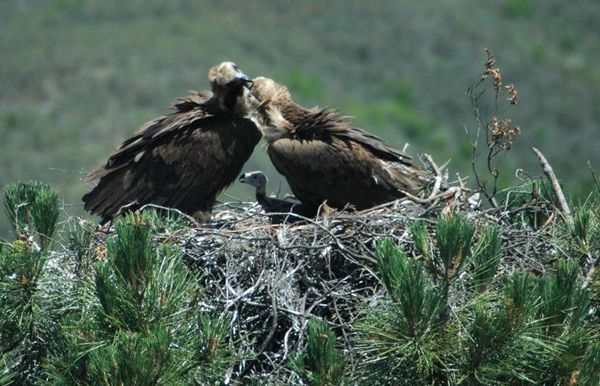
On this corn oak’s right side, the other parents watch how their chick tries to fly. The sound of a snort in the air, and a pair of wing beats precedes its violent landing with his outstretched wings. The learning and training of these movements are essential to ensure the survival of both chicks. Soon they’ll leave their respective nests and will go hundreds of miles away from this place.
Look now at the scene’s right side. Under the branches of the third corn oak tree, where a noisy flock of magpies has nested, have shown up by surprise two individuals of the most endangered felines in our lands: The Iberian Lynx. Sssshhh, get closer, stop the audioguide and try not to make any noise! While one of them is resting, the other one approaches stealthily a rabbit which doubts to come out at the warren entrance. Rabbits are their main source of food and they can’t pass this opportunity up, since every day is harder to find them.
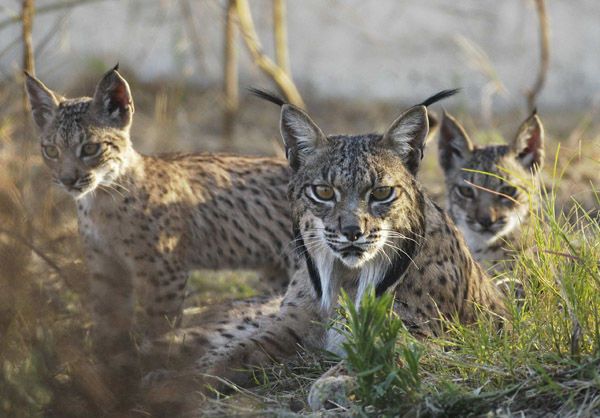
In and out in a flash, the Iberian Lynx has caught the rabbit and the ambush has been a success. The morning has started well for these two Iberian Lynxes, but they need more proteins so they’ll have to hunt down another rabbit before the end of the day.
If you want to know more about the Mediterranean forest and the species that inhabit it, get closer to the screens which are next to the scene and enjoy the activities that we suggest. With the interactive "Who's who?" you’ll be able to get more information about the scene and species represented in this room. The game "Explore the forest!" allows you to know better the most characteristic species of the Mediterranean forest. I’ll be waiting in the next room in order to discover Cabañeros Park’s deciduous forest in the fall.
10. The deciduous forests in the fall. A symphony of color
- Spanish voiceover
- mp3 format
- English voiceover
- mp3 format
- French voiceover
- mp3 format
Time goes by with the audioguide and November moves forward in Cabañeros Park. There are still dry leaves to fall from some deciduous trees’ tops, being most of them on the forest’s ground forming a golden carpet. We are within a thick oak wood. The beauty of this magical landscape is amazing, but winter is around the corner and the morning is going to be very cold and humid, especially in the shade under the trees. It‘s a clear sign that this year snow will come a few weeks earlier. Stand in front of the scene. You’ll be able to see how some species live and fight for their survival in this forest.
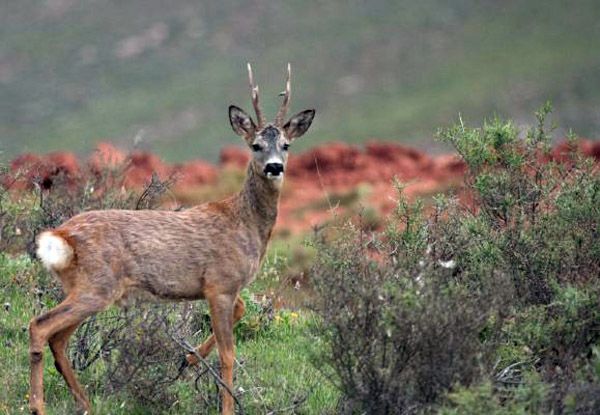
To the left, in the foreground, you can see an oak tree’s trunk without any leaves. Behind appears a surprised Roe Deer that had been hidden in the undergrowth. It’s a male Roe Deer with his unique three peaks antler and gray dense fur which help him to camouflage and withstand the cold winter.
Frightened by our presence, he runs away after giving a powerful jump thanks to his strong back legs.
Look up now along the oak tree’s trunk where you’ll come across with some interesting birds. Such as this Blue Nuthatch, running down the tree’s trunk upside down in an acrobatic pose. Their strong claws allow him to hold to the bark to make these strange movements while singing.
A little bit further up on the left appears a Woodpecker, a skilled carpenter which knows how to work the bark to find grubs and insects whose beak’s patter against the wood is heard at great distance.
Perched on the branch there are two colorful birds, a quiet Robin singing a melancholy tune, which as a soloist singer, there is no other bird in the fall that sings in such way.
At the branch’s end you can see a Eurasian Jay. He’s just kept in one of this oak tree’s hollow a few acorns which had collected on the ground. His pantry is already quite full ready for winter and it looks like the strident croaking that gives out means the satisfaction for a job well done.
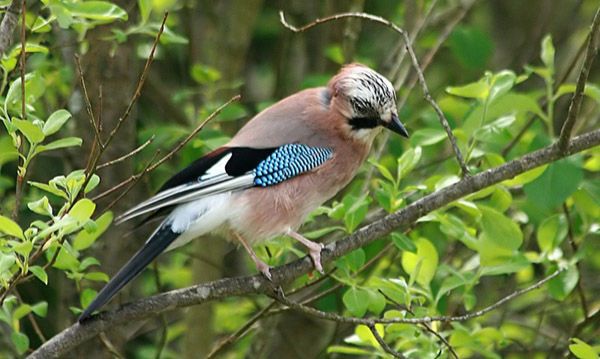
Soon his pantry won’t have an owner. A Northern Goshawk in a spectacular maneuver dodging the branches is about to fall on the unsuspecting Eurasian Jay. It’s a relentless hunter, hardly ever fails and probably won’t this time.
Unless that specimen is taken by another fearsome bird of prey in the forest such as the Eurasian Sparrowhawk which approaches swiftly from the scene’s right side. Although the Eurasian Sparrowhawk usually hunts smaller birds, the female has a preference for Eurasian Jays.
The end of the Eurasian Jay is sure, nature must take its course and the laws of the food chain are relentless.
Look now at the scene’s lower right side while you keep on listening to the audioguide. Next to a dry trunk and a fern appear four very common mammals in these forests. Let’s see if any of them ring a bell. Do they? I’m sure one of them may sound familiar. A lonely Common Hedgehog with its characteristic chubby appearance and spiky fur, looking for insects and berries on the ground. Although it is mostly a night animal, often comes out in cold and wet days like today.
Above him on the tree’s trunk appears a Garden Dormouse also of nocturnal habits like the hedgehog which has taken advantage of the cool morning to collect acorns. He still needs to get a lot of food to get through the winter while he is in hibernation.
This Garden Dormouse is going to get a real fright. He’s about to come across two common predators. An absent-minded Beech Marten has just come out of its burrow to look for something to eat. She’s hungry and has no special preferences. It could be rodents, voles, reptiles, eggs, fruit, berries...
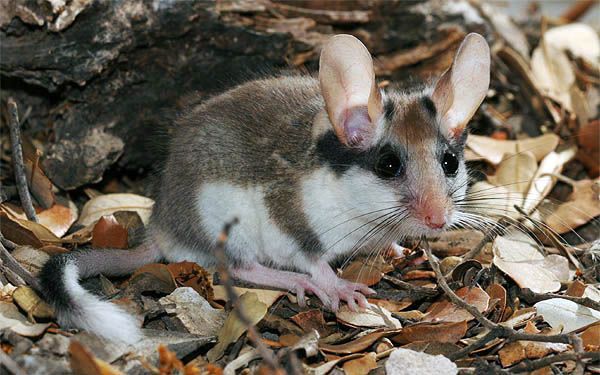
Further below, a Badger with its distinctive white head crossed lengthwise by two black stripes. Omnivorous as well as the Marten, has a preference for fruits, honey, berries and plants. This animal is known as "the most vegetarian between carnivores".
If you want to know more about the deciduous forest and the species that inhabit it, get closer with the audioguide to the screen that is next to the scene and enjoy the activities that we suggest. With the interactive "Who's who?" you’ll be able to get more information about the scene and species represented in this room. The game "The detective of the forest" allows you to learn more about the fauna of Cabañeros Park’s deciduous forests. I’ll be waiting in the next room to find out about Cabañeros Park’s rivers and riversides in the fall.
11. Rivers and riversides in the fall. Life returns to the river
- Spanish voiceover
- mp3 format
- English voiceover
- mp3 format
- French voiceover
- mp3 format
Night is falling in Cabañeros Park, the sun hasn’t set yet on the horizon, but temperature has dropped quickly. The days are getting shorter and shorter and seem to leave too quickly. We are within a leafy riverside forest going along the wild and untamed Estena riverbed on its way through the Park. Between a corridor of willows, black alders and ashes, the Estena River’s seasonal water runs down during these first days of December with more water than usual. Fall has been especially rainy which can be noticed in the streams water level which flow into the main river course. Water, always synonymous with life, is full of fish and becomes now a big attraction for many species that visit Estena’s riverside. Let me introduce you to some of them. Look first at the river’s water, small schools of fish swim in it, where you can see from left to right Barbels and other Ray-Finned fish.
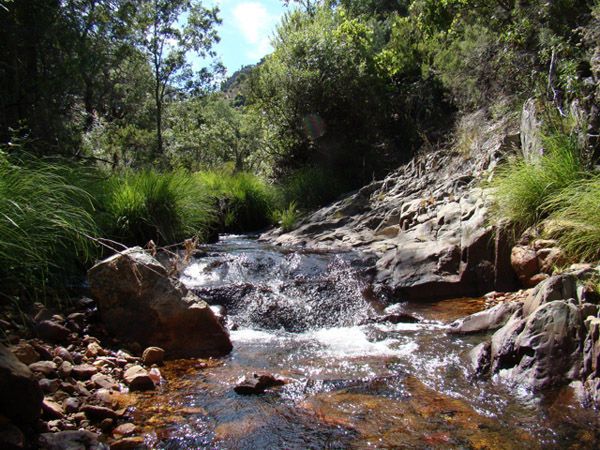
Among them an otter has just dived into the water to look for food such as crabs, reptiles and even birds, being fish their main diet. Skilled swimmer and diver can stay under the water for up to 3 minutes. Right now he’s about to catch a Barbel which will share it with his partner waiting on the riverside. Can you see her? Next to her on her right, a Grey Heron shows up. She’s been perched for hours on a rock that barely sticks out from the water with her neck shrugged and craned beak pointed horizontally. She remains still watching the water bottom and any fish that passes within her reach will be skillfully captured.
Further to the right we have a Water Vole which is about to dive into Estena waters. She's in a hectic activity of recollection since she has to fill her burrow with food to be able to spend the harsh winter. She’s able to accumulate several kilos of plant matter, insects and tubers.
Next to her appears a lonely White Wagtail pecking repeatedly at the ground to feed on small insects. His partner must not be far because at this time of the year they are very loyal to a small piece of territory.
Now at one end of that part of this scene, we can find a quiet European Pond Turtle. He's come out from the vegetation that gives her protection heading slowly toward the river. It’s at this moment when he’s most vulnerable to potential predators, while in the water he’s an excellent swimmer.
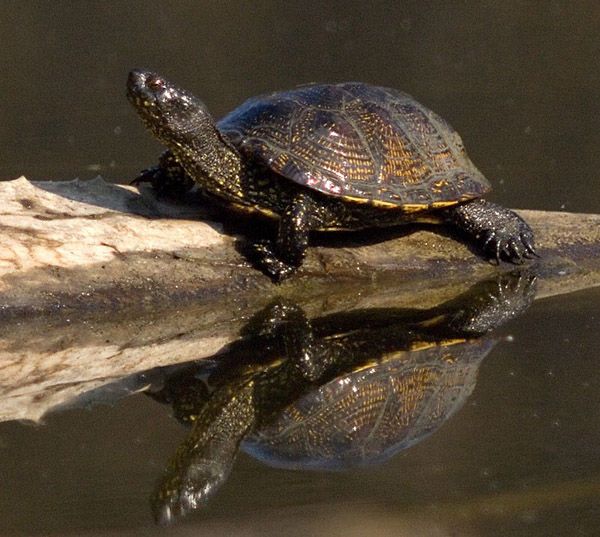
The audioguide suggests that you look now at the scene’s left side. First of all, three amphibians that are very common in these forests show up, such us the Common Frog, the European Tree Frog and the Iberian Painted Frog. All three are of twilight habits and have just come out of their hiding to feed on small insects.
To the right there is a coiled Viperine Water Snake. It’s not frequent to see her at this time during the cold month of December, but hunger has made her to come to this place. One of the three previous amphibious will certainly become a prey difficult to resist, although the Fire Salamander, which remains still on the right side, could also be one of them too.
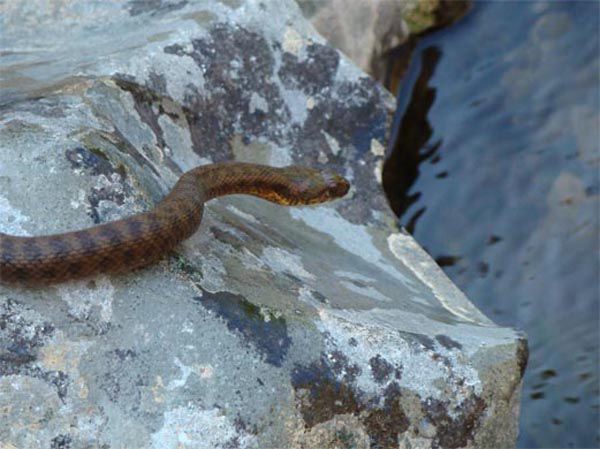
A little bit further appears a White-Throated Dipper and an Iberian Emerald Lizard searching carefully for worms and insects in the riverbank mud.
If you look up now you’ll see a beautiful River Kingfisher with his brilliantly colored plumage. He’s carrying in his beak an aquatic insect which has just hunt.
We've told before that the Estena River flows this year with more water than usual which has caused, as you have seen before, an overabundance of prey for all species. Paradox of nature, water is life and death at the same time, necessary balance for survival in any ecosystem.
If you want to know more about the Park’s rivers and riversides and the species that inhabit it, get closer to the screen that is next to the scene and enjoy the activities that we suggest through the audioguide. The interactive "Who's who?" will provide you with more information about the scene and the species represented in this room. With the game "Amphibians puzzle" you’ll learn in a fun way, very interesting information about this type of animals. I’ll be waiting in the next room to learn about Cabañeros Winter Solstice.
12. Winter Solstice. The longest night of the year
Let's continue our journey with the audioguide. The month of December has brought to Cabañeros Park shorter and shorter days, a tendency that will change tonight, the longest of the year, when takes place the Winter Solstice and the change of season. Starting tomorrow and almost imperceptible, the day will slowly gain minutes to the night until the Summer Solstice is reached again. A date which is today quite far due to the gelid temperature around us in the scene we have in front of us.
It's almost midnight and there is a hard frost in the Park. A huge full moon floods with light this forest shed of leaves, trimming the tree logs’ shape. It does it with such intensity that lit a cave’s entrance where several nocturnal raptors have spent the day. They’re now taking over from the diurnal species which are taking their places in this scenario somewhat spectral.
Like this Barn Owl flying stealthily the scene’s left side. Look closely, he’s carrying in his beak a tiny field mouse that has just hunt on the ground which now is slowly flying up towards the nest.
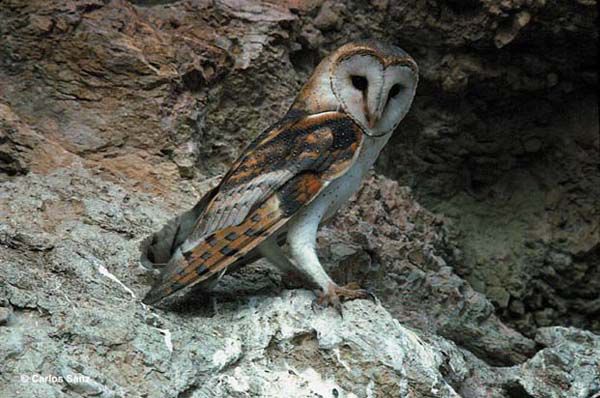
A little bit more to the right, perched on the tree’s bare branches, show up a Eurasian Eagle-Owl and a small Little Owl. The first one is the biggest nocturnal raptor in the forest, which seems to sing to the moon with his loud and insistent hooting that can be heard far away. But it’s really a territorial song that marks the area occupied with his partner. Therefore, each Eurasian Eagle-Owl has a distinctive sound which is used to identify them. His night vision and hearing acuities are extraordinary and I think he's heard us; he’s just turned his head to watch us with his big orange eyes. Let's continue without making any noise.
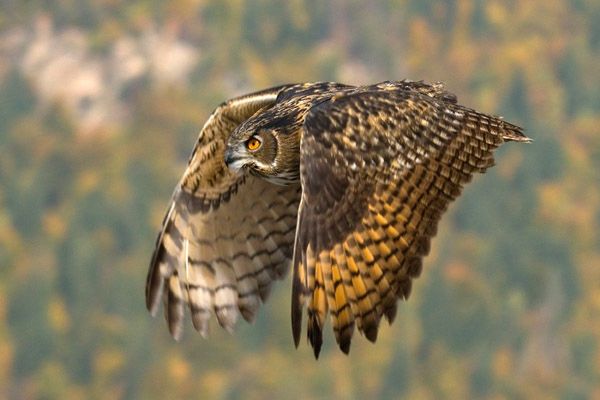
A chubby and lonely Little Owl is perched on another tree’s branch. He’s been there still for a while looking around while emitting a distinctive sound which sounds like a harmful plaintive mew.
Further to the right, perched on two different trees are a Long-Eared Owl and a Tawny Owl. In between, there is a very tempting prey for all predators present at the scene: It’s an absent-minded Wood Mouse searching for food which will pay dearly for his mistake. The Long-Eared Owl has one of the most sober sounds among birds, like the sound you hear when blowing an empty bottle’s top. This sound has also, like other night predators, a territorial meaning. All of the sudden, he flies off to hunt that little mouse. He does it with remarkable skill and in complete silence, zigzagging between the trees’ branches without touching them until falling over his prey.
On the tree which appears on the scene’s further right side, there is perched a Tawny Owl. It’s a male cleaning his plumage while hooting in a persistent way. He has established a flirty dialogue with a female which responds from far away with a high shrill sound. The courtship between the two of them has begun and will last all night long.
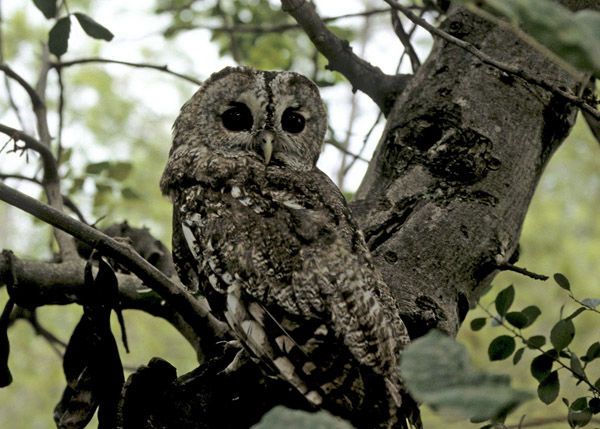
Look now at the scene’s ground area. The audioguide will allow you to see several boxes lit alternatively showing six different bats species present in Cabañeros Park. Pay attention, from left to right will show up a Vesper Bat, a Pale Serotine Bat, a Greater Horseshoe Bat, a European Free-Tailed Bat, a Greater Mouse-Eared Bat and a Grey Long-Eared Bat. Don’t miss the group of Greater Horseshoe Bats hanging from the cave’s ceiling.
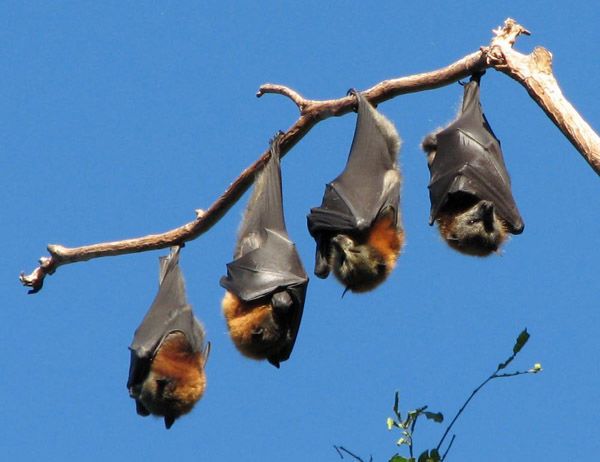
All these species that you’ve seen have developed an extraordinary and unique characteristics to adapt and survive in the dark. They are Cabañeros’s night inhabitants.
If you want to know more about the Park’s night and rupicola wildlife, get closer to the screens which are next to the scene and enjoy the activities that we suggest. The interactive "Who's who?" will provide you with more information about the scenes and species represented in this room. With the game "A radar in the dark" you’ll learn in a fun way many things about bats. I’ll be waiting in the next room to discover with the audioguide the winter season in Cabañeros Park.
13. Winter in the water. The wind dance
Cabañeros Park’s wetlands, such as this small pool formed by the abundant rains that fell last fall, have been a refuge during the last three months for thousands of wintering birds which arrived with the first frost. Now we are in the last two weeks of February. The days begin to be a little bit longer and the temperature remains the same. We are in the toughest month of winter since it’s colder and snowfalls are more common. Despite that, the wintering birds’ instinct begins to be active again. The call back to their breeding grounds in central and northern Europe is about to begin.
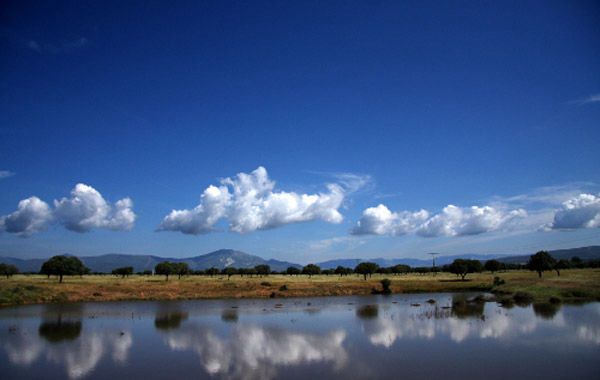
As it’s happens in this scene to these groups of birds. After resting in their sleeping places during the night, they take advantage of the early morning to feed themselves and start off their journey northward. The din of honking from a large flock of cranes can be heard from miles away. It’s an overpowering noise because the crane, one of the noisiest birds, is the great protagonist at this moment. Several flocks have been gathering in this wetland to set out for together. Notice the elegance of their slow movements, either still or moving. Their figure is unmistakable, with their legs stretch out and their neck extended or bent backwards while singing.
Look now closely with the audioguide. Can you make out the cranes which have their head covered by a yellow plumage? They’re a few chicks in the group surrounded by adults. While some cranes are already in the air, some others begin to join them once flying off after running a few meters with their wings already deployed in a very characteristic movement from this species. Those falling behind have stayed a few more minutes feeding on roots, worms and insects in the mud and on the pond’s banks. They know their journey will be long and won’t be able to stop until dusk.
Look now at scene’s right side. On the ground, among the group of cranes, appears a pair of Mallards. The male is easy to identify due to its colorful plumage: glossy dark green head and neck, and reddish brown chest. Matched from the beginning of winter, they have settled permanently close to this pool, where they have just built their nest among the reed bed on one of the river banks. The female is about to lay eggs in a week. She will lay between 7 and 12 eggs.
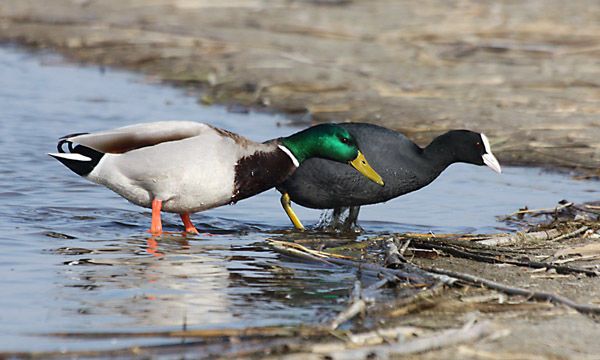
Further to the right, another pair of Northern Lapwing has chosen this wetland to nest. Although it’s a very gregarious species, during the breeding season they live apart, that’s why both seem to be restless while exploring the pool vicinity. The Mallard and the Northern Lapwing are two wintering species which live in Cabañeros Park throughout the year. The specimens coming from Europe which arrived at the beginning of winter will return to their breeding territories.
Look up now and notice the large flock of Common Wood Pigeons crossing over the sky above this pool. They are Common Wood Pigeons which are returning to their places of origin. Hundreds of thousands of these birds will cross in a few days throughout the Pyrenees Far West on their way home.
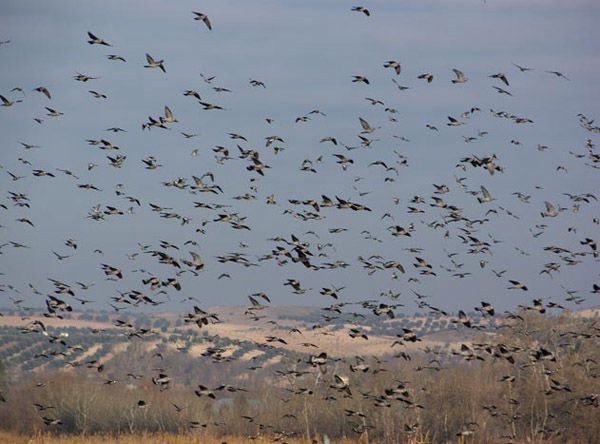
This flock of Common Wood Pigeons is a very tempting target for two elegant air predators such as the Red Kite and the Black-Winged Kite. Neither of them can waste such a favorable opportunity.
The first one, much bigger, approaches the pigeons spreading his wings while his long tail acts as a powerful helm. Practically still, hanging in the air, is about to catch a pigeon with his claws. The Red Kites are now returning to their breeding areas in Switzerland and Germany, so feeding well is a vital objective for these specimens to finish off their journey.
The Black-Winged Kite is about to wrap around his prey. After flying quickly with his wings in angle around the flock of pigeons, all of the sudden folds them up falling straight on the target.
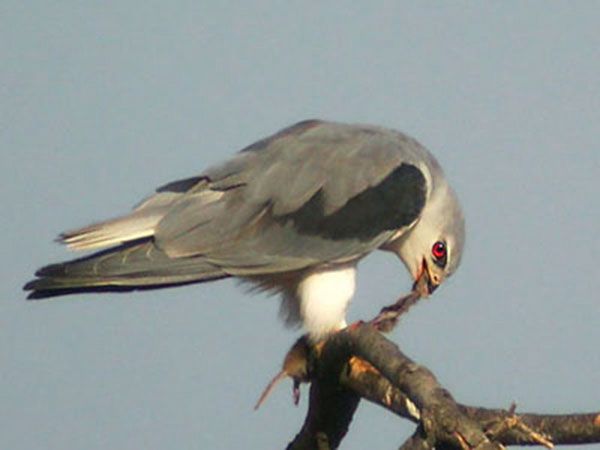
The cool morning moves forward in Cabañeros Park. The birds’ sounds that will cross the bright sky today are spreading out into the air and will not begin to fade until sunset.
If you want to know more about wintering birds, the wetland ecosystem and the species that inhabit it, get closer to the screens that are next to the scene and enjoy the activities that we suggest. With the interactive "Who's who?" you’ll be able to get more information about the scene and species represented in this room. And with the game "On route" you’ll be able to know better the European migration routes of four species that spend the winter in Cabañeros Park. I’ll be waiting in the next room to discover the mountains in winter.
14. Winter in the mountains. Owners of the summits
We are now passing through the “Rocigalgo Massif”, Cabañeros Park’s highest mountains. We find a large outcrop of quartzite rock from where hang small torrents caused by the winter streams originated in these summits and in some cases create waterfalls of great beauty. The sun rose a couple of hours ago and the wind don’t stop whipping these naked cliffs. This cold February morning comes with a bright and clear sky that offers some splendid views of some lesser-known landscapes in the Park.
Look at the scene’s left side. With the audioguide, along with some junipers you will find a group of Iberian Wild Goats. It’s easy to tell apart the two males from the female due to their impressive antlers. It’s not still easy to see it but the female is pregnant. If all goes well, the new baby goat will be born in May. The males are two young specimens which have been playing for a while. Half playing, half training, their instinct leads them to imitate the adults behavior in fights that often hold during the mating season to decide which one will mate with the more number of females. One of them has found a higher position among the rocks and is about to stand up on his hind legs to fall down against his opponent.
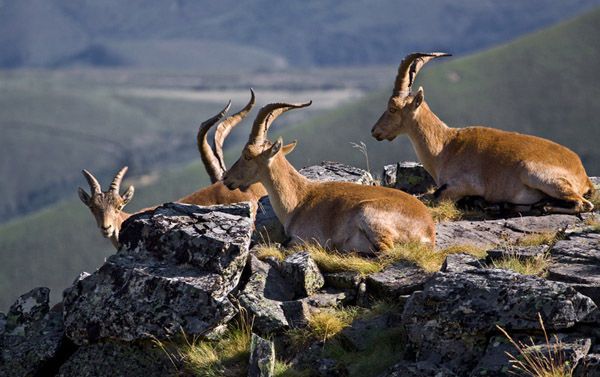
The dry and strong sound of the antlers clashing each other is repeated by the echo in the silence of these mountains, showing the violence of these terrible blows. Within minutes, one of these males will accept defeat and will run away from this place to look for new clashes against other males. This will be the last training for these two males. In a few months they will have reached full sexual maturity and at the end of the year they’ll put into practice everything they’ve learned in these games. Keep listening to the audioguide and look now at the scene’s right side where stands out in the foreground two exceptional animals.
First, a superb male deer specimen seems to pose in front of us. We've laid our eyes on him far from the vegetation protection and remain alert watching our movements. His antlers is about to fall at the end of the winter season. It’s common to see them wandering alone in these mountains, because the males only join the females in the mating season, when the famous deer bellow happens.
A little further to the right, flies over the most majestic bird in the Iberian Peninsula skies: A Golden Eagle. With her wings spread out and still, seems to rest on an invisible current of air that rises her up gently between the cliffs of these mountains. Her powerful and elegant flight technique allows her to keep control of her actions even with the strongest headwind.
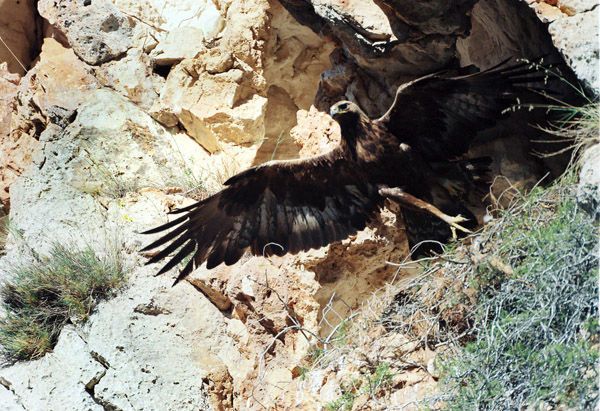
It’s a female whose partner must not be far. They are very territorial especially during the mating season. They have built a nest on a close cliff, taking advantage of a hollow on the vertical wall of that cliff. Look now a little bit further down where there’s also a small community of birds in that same cliff. Although they not sing much in winter, some trills resound into the silence of these summits. To those most common birds from these places such as the Alpine Accentor and the Black Redstart, a small flock of Common Chaffinches and a lonely European Robin have joined them being more usual in wooded and lower heights.
In order to identify them well I’m going to tell you exactly where they are. From left to right you can see a pair of colorful Alpine Accentors, the more used to the cold from these summits.
Further to the left there is a Black Redstart that stays still on a rocky ledge, one of his favorite perches from where he can spend hours waiting to watch impassively the next meal.
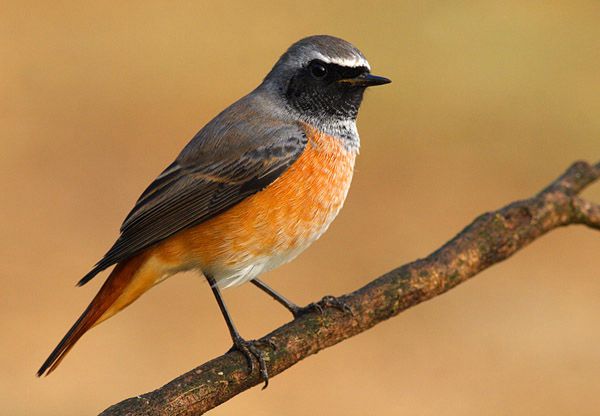
Next and further down, the sonorous and metallic trills of a European Robin and three Common Chaffinches intermingle creating a small hullabaloo not common in Rocigalgo.
If you want to know more about the wildlife that inhabits this park’s mountains, get closer to the screens that are next to the scene and enjoy the activities that we suggest. With the interactive "Who's who?" you’ll be able to get more information about the different scenes and species represented in this room. With the game "Who lives over there?" will allow you to know the different ecosystems that are in Cabañeros Park according to the altitude and which species inhabit them.
And here, in the “Rocigalgo Massif”, at 1,448 meters above sea level, on the highest point of Toledo Mountains, we conclude the first part of our audio-guided tour through this Cabañeros National Park’s Visitors’ Center. We have witness the different changes that occur throughout the four seasons during 365 days. A series of transformations and events that, although very often we are not aware of them, they happen every year but this time you have seen it with your own eyes.
We’ve seen in the audioguide how this annual cycle began last spring when the storks started to arrive to the Park, and the cranes which had spent the winter in Cabañeros Park started off their journey northward. Everything starts all over again, everything will happen again in the coming months, because nature is in constant cyclical movement since it has been always like that.
I hope you have enjoyed this part of the visit and have found my company useful. I’ll be waiting in the following rooms.
17. The nature conservation and the rural development
We are now at the Connection Aisle, an area that connects the Room of the Seasons, where we have been before, with the Farmhouse, where our tour continues with the audioguide. As in other corners of the planet, the towns’ inhabitants closest to Cabañeros National Park have been protagonist for generations in an exceptional relationship with their surroundings. Over centuries they have been introducing in their traditions and trades the wisdom of what nature essentially meant as an integral part of the life cycle which their own existence depended on.
In the relentless search for tools and ways to establish a balanced relationship with the environment around them, nature’s indelible marks are in their history, in their memory and their emotions. The 1995 Cabañeros National Park’s declaration took into account these aspects and brought to this Toledo Mountains region a strong boost for its socioeconomic development, because until that time it was an area characterized by a high emigration and strong depopulation.
Four towns placed in the Province of Ciudad Real (Alcoba de los Montes, Horcajo de los Montes, Navas de Estena and Bullaque Retuerta) and two in the Province of Toledo (Hontanar and Navalucillos) have benefitted since then by the measures taken into account to ensure their sustainable development as well as improving the inhabitants’ quality of life. In the room you have some enquiry items in case you want know further information. You’ll find general documentation and tourist brochures published by different town councils in the region, with information about the wide range of accommodation and restaurants around the area. There’s also complete information about the activities proposed by rural tourism companies and active tourism.
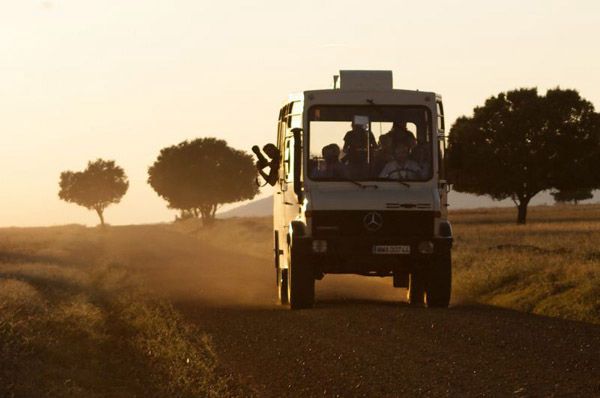
Stands out the customized guided tours through the park, on foot or by 4x4 vehicle, or themed routes: ornithological, photographic or during the deer bellow period. Not to mention in this audioguide the wine tasting at wineries, oil mills and traditional cheese making, where you can taste excellent products from the Cabañeros region. There is also a screen that has a simple and intuitive interactive enquiry which expands this information and displays a map of the park with the location of the six municipalities belonging to the Socio-Economic Influence Area.
18. The plant formations of Cabañeros
We continue our audio guided tour through the Connection Aisle’s ground floor. Here you can find information about the Mediterranean forest at Natura 2000 Network, the main instrument for nature conservation in the European Union. Established in 1992, it’s the world's biggest ecological network. It’s been used since them to give the Member States of the European Union a common framework in which to act in order to preserve the biodiversity in their territories and ensure the survival, long-term, of species and the most threatened habitats in Europe.
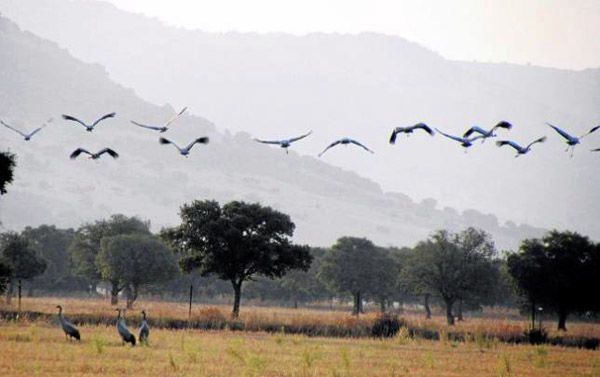
The Protected Areas that make up the Natura 2000 Network in Spain represent altogether a bit more than 28% of the territory, a fact that makes us the country that provides the largest area to this Nextwork. A great part of those protected areas are Mediterranean forests, the indisputable protagonists of the Iberian Peninsula landscape.
Look now at the model that is in the middle of the room. This scale model reproduces the Cabañeros National Park’s territory which shows the distribution of the different plant formations that can be found. With this and all you’ve been able to see earlier during the tour through the Rooms of the Seasons, I’m sure you’ll be able to recognize in the model Cabañeros’s most characteristic landscapes. I’ll be waiting at The Farmhouse, where I’ll tell you about the Park’s ethnographic values in the next audio of the audioguide.
19. The Farmhouse. Architecture and rural life
Our tour will pass through inside a Farmhouse in reconstruction, the architectural element that best identifies the popular architecture dedicated to fieldwork. These small buildings whitewashed or made out of exposed stone, which reflect like a mirror the sun in summer and hide themselves in the winter fog, were scattered in great number until not long ago in the surrounding fields next to Cabañeros Park. Adapted to the local environment, to the existing resources and to the needs of traditional agricultural farms, the Farmhouses were perfectly integrated into the surrounding landscape.
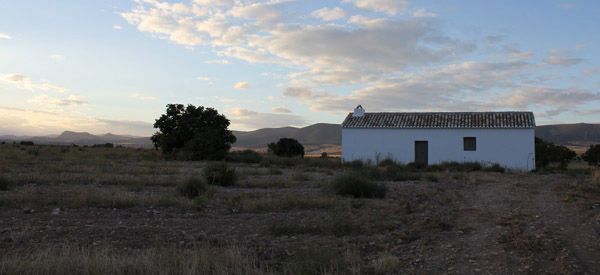
Look now the blueprint which is at the entrance. It will guide you on your tour through the inside of our Farmhouse. The following rooms that you are about to see with the audioguide are dedicated to value the fundamental role of the holm oak in the Toledo Mountains region, where the Cabañeros National Park is located. The holm oak has been so important for its inhabitants that it has been called "The Tree of Life". Almost everything keeps revolving around the holm oak, since it is almost an inexhaustible supply of material resources and center of the local culture from an anthropological point of view.
ts wood, its bark, the acorns that provide, its value in shaping the landscape of pastures or associated to the shrubland and Mediterranean forest. I’ll be waiting in the next room, where I’ll tell you more things about the use of holm oak wood.
20. The Farmhouse. The Room of the wood
The holm oak wood has always been highly regarded in the traditional work due to its hardness and density. It was widely used for making wheels and cart axles.
It was also used to make beams and columns for buildings and different farm implements such as plows, hoes, spades and rakes, and other small hand tools.
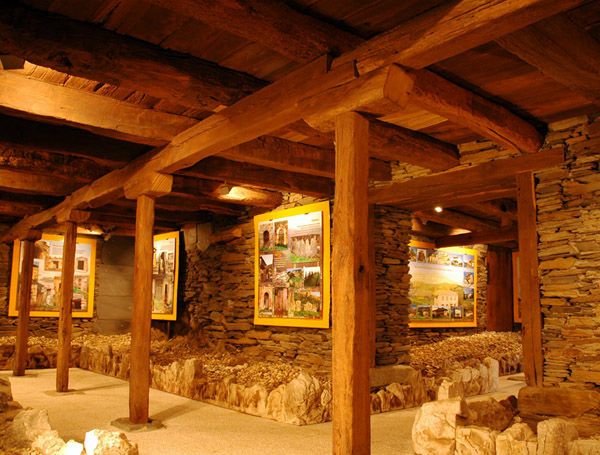
Due to its excellent resistance to moisture, the wood would be also used for irrigation channels and other minor irrigation systems.
Does that sound ring a bell? It’s the sound of cowbells. Their clappers, the piece that strikes the inside of the metal, used to be made of a thick splinter from the holm oak’s core.
The shepherds assure that with this material the sound could be heard from very far distances. They would recognize their flocks and allowed them to find a lost sheep or goat in the mountain. Look at now one of this room’s walls, where an array of these tools is shown. Let’s see if you can tell them apart!
Firewood and charcoal were other holm oak wood’s common uses, the most prized from our forests due to its high calorific value. The wood used to come from pruning, while coal was obtained in ovens, where wood was burned slowly for days. We are in the next room, where we’ll see what products give us the thicket.
21. The Farmhouse. The thicket Room
For centuries, plant species that inhabit the Park, have supplied the nearby inhabitants with endless natural resources. Notice the wall mount graphic along one of the room’s wall. Many of the plants and fruits needed during the crafting of some products are shown.
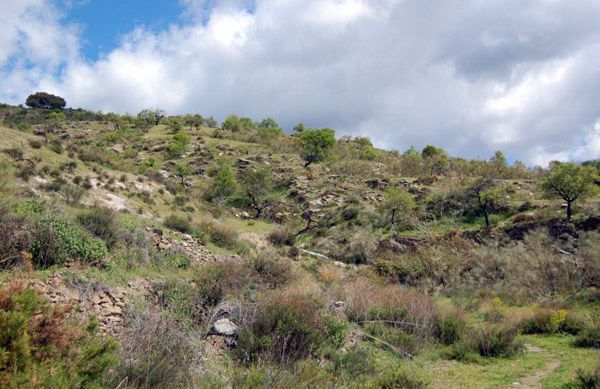
Some are as good as the exquisite rockrose or heather honey which beekeeper artisans collect each year from the beehives set up in the bushes, near those meadows flooded in color in spring. In the middle of the panel one can see the scenic recreation of a traditional beehive and the hologram with a cloud of bees around it. They look real, aren’t they?
Other as practical as natural insecticides made with thyme or cosmetics made by mixing lavender and other aromatic plants. Get closer to the panel’s right side. You’ll see some of these plants’ smell diffusers so that you can distinguish their special aroma.
Others as tasty as thyme, dill or oregano, which are essentials to finish off a good meal.
And what better way to start a nice meal than having delicious jams and liqueurs obtained from fruits and berries such as the strawberry or the blackthorn. I'll be waiting in the next room where we’ll discover the bark’s secrets in the next point of the audioguide.
22. The Farmhouse. The room of the bark
In this room we’ll see the traditional uses and implementations of holm oak’s and cork oak’s bark.
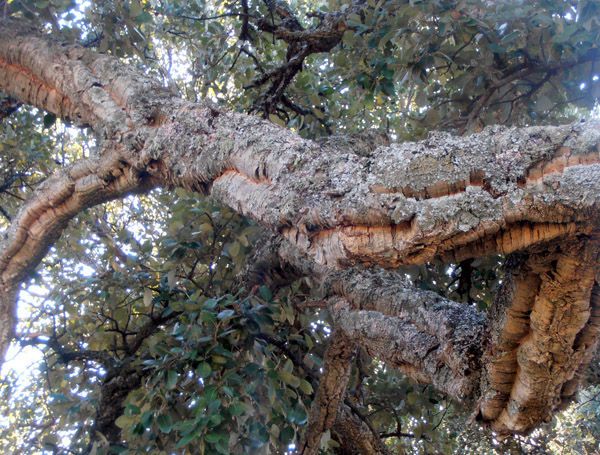
Look at the two mannequins that are next to the livestock’s drinking trough. They are dressed in leather garments and accessories, hand-crafted from cattle’s fur which frequent Cabañeros National Park. In this tanning process was used the bark from Holm oaks’ branches. Rich in tannin was considered the perfect natural tanning which avoided the fur decomposition. Let’s listen now to the audioguide talking about another bark’s traditional use.
Even today, as it has been happening for centuries, still exist one of the most interesting traditional activities in the Spanish mountains: the uncorking. Do you know what is it about? What does this word sound like to you? I’m sure you've guessed it. It’s the manual and handmade removal of cork oak’s bark to obtain cork. On the video screen, on the right wall, you can watch the uncorking process.
It’s not a job that anyone can do. It takes great skill and the right tools for this task. But there are days that are more complicated than others and trees tougher to uncork. Trees which have branches curved downward, called "sobaquera", trees with small branches or "canutos" and those which have many interconnected branches, known as "horcajás". The gang you hear has been working hard on this cork oak for several days. They climb up the trunk without the help of a ladder and from above they take off the cork sheet carefully not breaking it.
Once on the ground, they are piled in 6 layers to be loaded onto the mule’s back. This is a way to transport the cork which is still used today in Cabañeros Park due to the rugged terrain where they usually work.
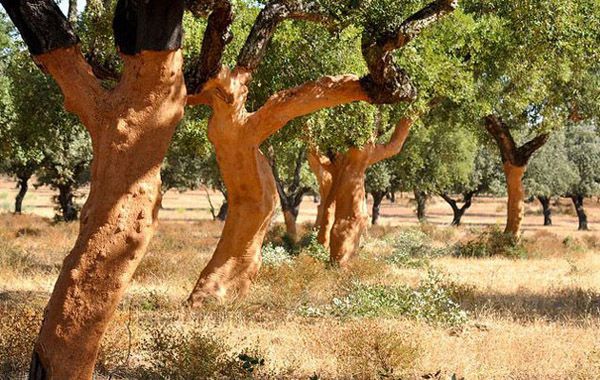
Once the cork has been processed, a multitude of objects are obtained such as: caps, insulation, flooring, decorative and gift items, blackboards ...
Would you have ever imagined that some of them could have come from this National Park? We continue with the audioguide in the next room, dedicated to the animals’ role in the Farmhouse’s traditional economy.
23. The Farmhouse. The Livestock Room
We are in the recreation of the Farmhouse’s interior space which corresponds with the stable. Here were kept and fed mainly the beast of burden and tools that were used in different agricultural tasks. Mules and plow horses were very important in the past for farmers in the Toledo mountains’ region, for carrying heavy loads, working the land or pushing small waterwells for the irrigation of vegetable gardens.
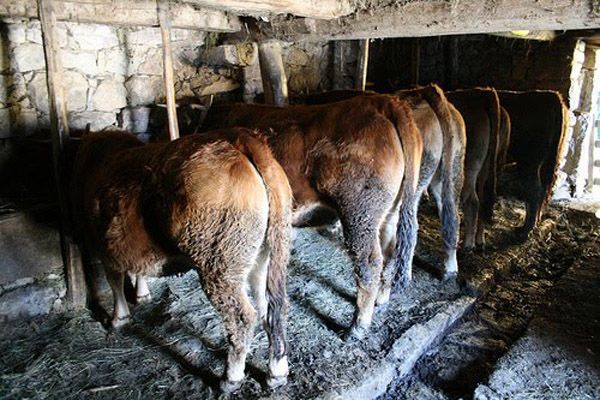
In the previous room you could see a trough, which was used by the animals to drink. The stable inside the Farmhouse had a double purpose. Protect the domestic cattle and heat the area where the farm labourer slept. In these stables used to keep cows, mules and sheep.
Grazing is another traditional activity which is carried out in the National Park. Many of the things you've seen before in leather have been made by the shepherds for their ordinary tasks: backpacks to carry food and small tools, chaps and half legs to protect themselves when shearing; clothes to keep them warm; small knife’s handles to cut a big piece of cheese...
Although the most important purpose is the production of sheep and goat meat, there is another product that stands out for its excellent quality made handcrafted in all Cabañeros’ area: The sheep cheese.
Do you know where the cheese comes from? Look at the images projected on the stable’s scene. A large size audiovisual to scale creates an optical illusion which represents a flock of sheep.
You will be able to see how they are milked by shepherds. Obtaining milk is the first essential step in making cheese. Don’t make any noise in order not to disturb the animals. We are standing with the audioguide in the next room to talk about the acorn and its qualities.
24. The Farmhouse. The fruit room: the acorn
The Iberian pig is the domestic animal that best represents the pastures’ landscape in Cabañeros Park. Loose among holm oaks and corn oaks, these pigs grow freely feeding themselves with grass and mature acorns they find on the ground.
This traditional activity, called “montanera”, remains even today and employs many shepherds, like this group we are listening now, who takes care of this meadow and the pigs that live there. They are hitting with long sticks the holm oaks’ branches so that the ripe acorns fall to the ground. Soon they are surrounded by some pigs to eat them all.
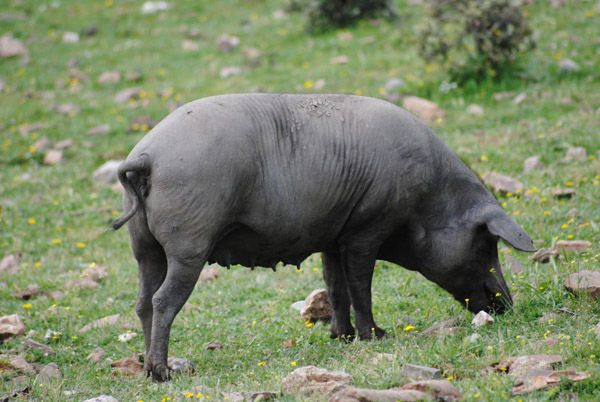
This diet and the exercise they do is the main reason for these products’ excellent quality which are extracted from these pigs, among which stands out the Iberian ham. But to reach the cure or these hams is not an easy task. After starting in the pasture, as we’ve seen before, the next step is the annual slaughter ritual, which in the Cabañeros’s area is still performed in the traditional way.
The pig slaughter lasts three days and takes place during the coldest days of the year. Low temperatures do not encourage to enjoy the party, but it’s necessary for a good cure process of the products obtained. These are very important in the local domestic economy since they are devoted exclusively to self-sufficiency and give extra food to the families. Slaughtering is still today a day of celebration where neighbors and relatives, meet and help among each other. Communal meals where work and festival blend in perfect harmony.
In this room you’ll find also four screens. Each one shows an audiovisual that explains in a simple and entertaining way the entire process of slaughtering, in other words, how to turn acorn into ham. We are standing in the next room, where we’ll finish our tour through the Farmhouse with the audioguide.
25. The Farmhouse. The forest room
We are in the Farmhouse’s sixth and last room dedicated to explain traditional hunting activities practiced in the Park’s surrounding.
Within its limits hunting is not allowed, although outside of it is. One of the most common is called “La Monteria”, like the one we are now, where it seems like we are in the middle of it. A pack of dogs has found a wild boar that has just run away like a bat out of hell. Its huge body hits violently against the lower branches leaving an easy trace to follow by these well-trained dogs.
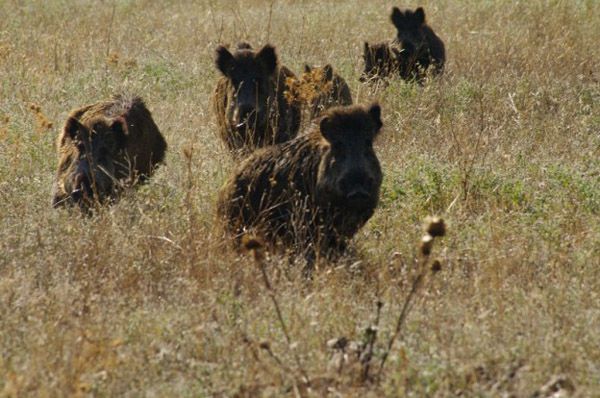
The pack of dogs chases the wild board at full speed. The dog wardens behind them don’t stop, at any time, to encourage them to keep the pursuit pace.
The wild boar has very little chance of escaping. If he manage to cross the river through a ford he may fool the dogs, but he’s been running for a long time and he is not a long distance animal.
The shots that sound far away seem to indicate that he wasn’t able to escape. The hunters, gun in hand and situated on high ground to get a better view, have claimed their trophy today.
The small game category has as objectives hares, partridges, turtledoves and common wood pigeons like this flock which is now crossing this forest’s sky. Today they can leave calmly. The hunters we've seen before seem already satisfied with the wild boar they’ve just killed.
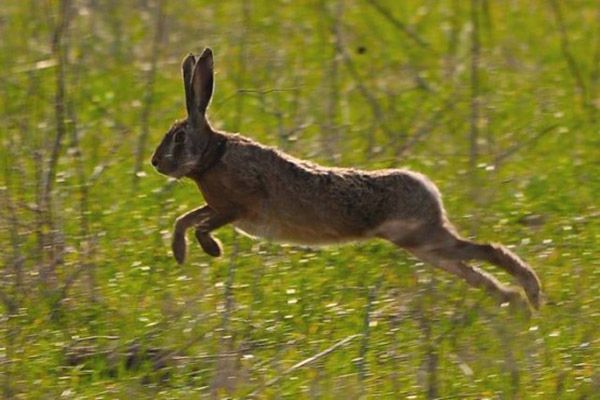
Notice the tracks on the ground. A good hunter would be able to recognize them immediately. Do you know what animals they belong to? Get closer to the screens which are between the columns. You’ll be able to see spectacular 3D backlit images related to hunting and their protagonists. And with this concludes our tour through the farmhouse. I hope you’ve enjoyed it and learned many things thanks to this audioguide.
26. Farewell
Here ends our tour through these Visitors’ Center’s rooms and begins the visit to Cabañeros National Park. You'll be able to see with your own eyes all that I’ve been telling you during the exhibition with the audioguide. I hope my comments have helped you to understand better what you've seen so far, and the things you are going to enjoy from now on.
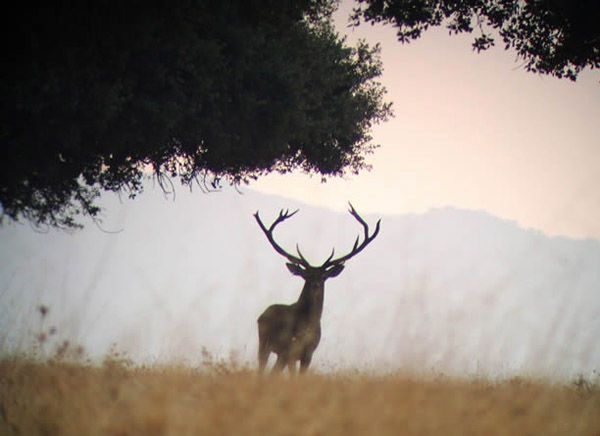
If you have any questions, ask my colleagues at the reception booth. And get ready to enjoy amazing experiences in the best possible atmosphere to watch wildlife in its natural habitat.
Thank you for visiting us! And hope you’ll come back soon!
Bluehertz Audio guides has developed for Cabañeros National Park Visitors’ Center an audio guide service avaliable in Spanish, English, French and German languages.
Cabañeros National Park Visitors’ Center address: 13110 - Horcajo de los Montes, Ciudad Real.
- Tel.: +34 91 597 65 77 - informacionma@magrama.es - www.magrama.gob.es/es/red-parques-nacionales/nuestros-parques/cabaneros
Back to index